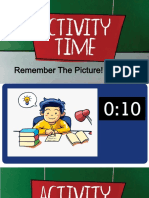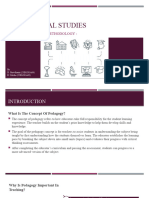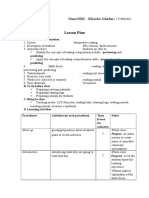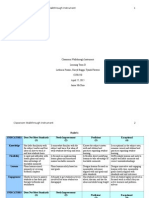0 ratings0% found this document useful (0 votes)
18 viewsMod 4
Mod 4
Uploaded by
Cleizel Mei FlorendoThe document discusses different types of inquiry-based learning approaches. It describes inquiry-based learning as engaging students through exploration and high-level questioning. There are four types of inquiry that can be used: structured, controlled, guided, and free inquiry. Problem-based learning involves solving open-ended problems in small groups, developing skills like problem-solving. Project-based learning engages students in planned tasks to solve real-world problems, developing research and communication skills. Technology can support these approaches by providing information and tools for collaboration.
Copyright:
© All Rights Reserved
Available Formats
Download as DOCX, PDF, TXT or read online from Scribd
Mod 4
Mod 4
Uploaded by
Cleizel Mei Florendo0 ratings0% found this document useful (0 votes)
18 views7 pagesThe document discusses different types of inquiry-based learning approaches. It describes inquiry-based learning as engaging students through exploration and high-level questioning. There are four types of inquiry that can be used: structured, controlled, guided, and free inquiry. Problem-based learning involves solving open-ended problems in small groups, developing skills like problem-solving. Project-based learning engages students in planned tasks to solve real-world problems, developing research and communication skills. Technology can support these approaches by providing information and tools for collaboration.
Original Title
mod4
Copyright
© © All Rights Reserved
Available Formats
DOCX, PDF, TXT or read online from Scribd
Share this document
Did you find this document useful?
Is this content inappropriate?
The document discusses different types of inquiry-based learning approaches. It describes inquiry-based learning as engaging students through exploration and high-level questioning. There are four types of inquiry that can be used: structured, controlled, guided, and free inquiry. Problem-based learning involves solving open-ended problems in small groups, developing skills like problem-solving. Project-based learning engages students in planned tasks to solve real-world problems, developing research and communication skills. Technology can support these approaches by providing information and tools for collaboration.
Copyright:
© All Rights Reserved
Available Formats
Download as DOCX, PDF, TXT or read online from Scribd
Download as docx, pdf, or txt
0 ratings0% found this document useful (0 votes)
18 views7 pagesMod 4
Mod 4
Uploaded by
Cleizel Mei FlorendoThe document discusses different types of inquiry-based learning approaches. It describes inquiry-based learning as engaging students through exploration and high-level questioning. There are four types of inquiry that can be used: structured, controlled, guided, and free inquiry. Problem-based learning involves solving open-ended problems in small groups, developing skills like problem-solving. Project-based learning engages students in planned tasks to solve real-world problems, developing research and communication skills. Technology can support these approaches by providing information and tools for collaboration.
Copyright:
© All Rights Reserved
Available Formats
Download as DOCX, PDF, TXT or read online from Scribd
Download as docx, pdf, or txt
You are on page 1of 7
Nature of Inquiry-Based Learning
Inquiry, in its simplest definition, is a process of asking
questions.
According to the Future of Jobs Report during the World
Economic Forum, the top three of the ten skills needed in
this age are complex problem solving, critical thinking and
creativity (Gray, 2016) which all start from the process of
asking.
as an approach essentially involves tasks requiring
learners' active participation in finding answers to
curricular questions.
Inquiry-based learning is a learning process that engages
students by making real-world connections through
exploration and high-level questioning.
Types of Inquiry
VIU (2020) presented four types of inquiry that can be
used in facilitating classes. These are:
1. Structured Inquiry - This lets the students follow the
lead of the teacher as the entire class engages in one inquiry
together.
2. Controlled Inquiry - The teacher chooses topics and
identifies the resources that the students will use to answer
questions.
3. Guided Inquiry - The teacher chooses topics or
questions and students design the product or solution.
4. Free Inquiry - Students are allowed to choose their own
topics without any reference to a prescribed outcome.
Role of the Teacher
The success of IBL largely depends on the careful planning
of the teacher in relation to the curriculum.
He/she controls and prepares the topic for investigation
and guides the learners by setting the questions to be
explored.
When designing an IBL, the teacher has to consider the
following fields proposed by Avsec and Kocijncic (2016):
1. Prior knowledge and capacity
2. Context-Learners require meaning from experience.
3. Content and learning materials
4. Process
5. Strategy of reactions and behavior
6. Course outcomes
Role of Technology
The internet or the World Wide Web offers lots of
platforms for mining information. It has become the most
sought out source of information because of the variety of
tools that abound.
many free educational websites
The technology tools that are made available for the
learners, whether online or offline, should support the
object of inquiry which is aligned to the learning
competencies in the K to 12 Language Curriculum.
It should be noted that the use of technology in IBL is just
one of the many other sources of information in the
process of inquiry.
Nature of Problem-Based Learning
Problem-based learning is an approach that involves a
process of inquiry and solving open-ended questions that
serve as the main problem that the learners will work on.
This learning activity is done in small groups with each
member assigned a certain task to accomplish.
they learn several skills such as problem- solving,
communicating, research, among others which are
essential in the workplace.
The end goal of PBL is to ensure that the target, the
learning competencies, are achieved in the process.
The student examines the problem given by the educator
and produces solutions for the problem by using both his
previous knowledge and the knowledge obtained by
researching.
Example : discussing snowmen and then asking a guiding
question, such as “How do we make a snowman?
Why useful to teachers? PBL units can not only empower
students but also ignite excitement for learning,
discovering, and questioning, which also brings educators
much-needed energy.
five principles of PBL that may be considered by teachers
in planning or using the approach:
1. It is a power of independent and self-directed learning.
2. Learning happens in a group and teacher is a facilitator.
3. All groups have to participate equally.
4. Students' learn about motivation, teamwork, problem-
solving and engagement with the task.
5. Materials such as data, photographs, articles, can be
used to solve the problem. (p. 73)
Lo (2009, p. 208) proposed a six-stage process used in the
adoption of the online PBL:
1. Identifying the problem current issues that do not have just
one answer or one definite solution;
2. Brainstorming generate ideas; tackle the problem through
self- directed questioning; arouse students' intrinsic motivation;
3. Collecting and analyzing the information-assigning group
members to collect information; posting what they found and what
they learned; collaborative collection of useful information;
4. Synthesizing information-solving synthesized relevant data;
knowledge building;
5. Co-building knowledge-presentation of the solution learning
problem/ issue; and to the
6. Refining the outcomes giving of feedback and suggestions
by the instructor to help students improve; learning from other
group's presentation.
Role of Technology
As the learners embark on an open-ended question
collaboratively, there are a number of free online tools that
they can use from the commencement of the task to its
completion
The WWW has opportunities for PBL that can be utilized
by the learners to accomplish their tasks.
Productivity tools such as those for writing, presentations,
spreadsheets, calendars, organizers, citations and others
are also available to assist learners and teachers in
accomplishing required tasks and outputs from a PBL
activity
Nature of Project-Based Learning/ Project-Based Approach
Project-based learning is an approach but has evolved as a
teaching method that engages learners in a series of
planned tasks resulting to the generation of solutions to
real-world problems.
This method is based on John Dewey's principle of learning by doing
and Vygotsky's constructivist theory of learning that advocates
social construction of knowledge
Past and more recent researches have proven PrBL to be beneficial in the
development of various skills such as:
1. Research methodology skills
PrBL could cause 100% enhancement of knowledge on the various
components of research methodology, update of the knowledge on a
particular topic, and increase in interaction with students.
2. Oral communicative competence
They also concluded that PrBL as a teaching strategy is effective
and is recommended as, suitable English language teaching
strategy especially for learners with low proficiency in the
English language.
3. Development of life skills
skills: responsibility, problem solving, self-direction,
communication, and creativity skills.
You might also like
- TTL 2 Chapter 2 Developing Project and Problem Based Instructional Plan Rev. 2021Document53 pagesTTL 2 Chapter 2 Developing Project and Problem Based Instructional Plan Rev. 2021Chloe Aravello100% (3)
- Guide - Introduction To TIPDocument48 pagesGuide - Introduction To TIPVenessa Mulig100% (1)
- (Past Simple Tense) Lesson PlanDocument2 pages(Past Simple Tense) Lesson PlanLogeswariy Selvaraju71% (7)
- Nature of Problem Based LearningDocument52 pagesNature of Problem Based LearningAlwyn SacandalNo ratings yet
- Revisiting of PB Learning Plan: Integration of The Use of Digital and Non Digital Resources and Assesment Tools in The LP ProcedureDocument12 pagesRevisiting of PB Learning Plan: Integration of The Use of Digital and Non Digital Resources and Assesment Tools in The LP ProcedureReca BoltronNo ratings yet
- Cumulative Learning Theory by R GagneDocument1 pageCumulative Learning Theory by R GagneReyna Mae MarangaNo ratings yet
- KSSM English Lesson Plan For Form 2 (Sample)Document1 pageKSSM English Lesson Plan For Form 2 (Sample)Syuhada Roki100% (12)
- Preschool Math LessonDocument2 pagesPreschool Math Lessonapi-40787547650% (2)
- TTL 2 ReportDocument16 pagesTTL 2 ReportlxcnpsycheNo ratings yet
- TTL 2 Presentation 2Document22 pagesTTL 2 Presentation 2BLESLYN CLAIRE LORENZO A.No ratings yet
- Integrating Active Learning Approaches in Language LearningDocument5 pagesIntegrating Active Learning Approaches in Language LearningGemmarie Roslinda PasionNo ratings yet
- Module 2-Integrating Active Learning Approaches in Social Science LearningDocument8 pagesModule 2-Integrating Active Learning Approaches in Social Science LearningMichael AngelesNo ratings yet
- TTL Module 3Document7 pagesTTL Module 3ronelinemalanaNo ratings yet
- Lesson 3 TTL2Document47 pagesLesson 3 TTL2fries riveraNo ratings yet
- MODULE 2 Lessons 1 and 2Document3 pagesMODULE 2 Lessons 1 and 2ANNAH GOMEZNo ratings yet
- Lesson 2-WPS OfficeDocument17 pagesLesson 2-WPS OfficeJohn Mark MapusaoNo ratings yet
- Pr0Blem-Based Learning AND Project-Based LearningDocument16 pagesPr0Blem-Based Learning AND Project-Based LearningKay DeeNo ratings yet
- Active Learning Approaches For Language LearningDocument32 pagesActive Learning Approaches For Language LearningJohn Michael LaurioNo ratings yet
- Technology and Teaching and Learning 2Document67 pagesTechnology and Teaching and Learning 2Jenefer Chavez-GuadalquiverNo ratings yet
- Inquiry and Research FINALDocument23 pagesInquiry and Research FINALAngelika SericonNo ratings yet
- Module 2Document4 pagesModule 2EdelNo ratings yet
- TTL 2 HandoutDocument8 pagesTTL 2 HandoutEzra PicaNo ratings yet
- Week 5 Learning ResourcesDocument4 pagesWeek 5 Learning ResourcesKim Angela Cordez100% (1)
- Group 2 Report For ttl2Document31 pagesGroup 2 Report For ttl2josephjaiddNo ratings yet
- TTL2 OutlineDocument4 pagesTTL2 Outlinejosuah OperarioNo ratings yet
- Reviewer For Final Examination in Teaching Technology in Elementary GradesDocument9 pagesReviewer For Final Examination in Teaching Technology in Elementary Gradestoriojocelyn16No ratings yet
- What Is Project BasedLearningDocument4 pagesWhat Is Project BasedLearningdarlene sarmientoNo ratings yet
- Local Media2505043014404894895Document31 pagesLocal Media2505043014404894895Janice Joy Ibañez AguilarNo ratings yet
- Integrating Active Learning Approaches in Language Learning - PBLDocument15 pagesIntegrating Active Learning Approaches in Language Learning - PBLrenair ravaloNo ratings yet
- TTL 2-MATH: Lesson 4Document7 pagesTTL 2-MATH: Lesson 4Efraem CelesteNo ratings yet
- Inquiry Based Learning - 085448Document6 pagesInquiry Based Learning - 085448josuah OperarioNo ratings yet
- Konsep FilsafatDocument8 pagesKonsep Filsafathafidh ainunNo ratings yet
- TTL ReportDocument50 pagesTTL ReportJasher JoseNo ratings yet
- Gangadharpur Sikshan Mandir: ContentDocument6 pagesGangadharpur Sikshan Mandir: ContentKUTUBUDDIN MOLLANo ratings yet
- TTL 2Document14 pagesTTL 2ordenizarheamaeNo ratings yet
- Impact of PBL On Student Centric Learning: AbstractDocument8 pagesImpact of PBL On Student Centric Learning: AbstractAgha Khan DurraniNo ratings yet
- TTL2-LESSON 3 Inquiry-Based Learning and Research-Based LearningDocument1 pageTTL2-LESSON 3 Inquiry-Based Learning and Research-Based LearningArciga, Sheena Mae BienNo ratings yet
- TTL 2 Midterm TopicDocument30 pagesTTL 2 Midterm TopicorillasheNo ratings yet
- Pedagogical StudiesDocument15 pagesPedagogical StudiesgowNo ratings yet
- Technology For Teaching and Learning: Elementary GradesDocument9 pagesTechnology For Teaching and Learning: Elementary GradesJessie CusiNo ratings yet
- Action Research For Using Problem Based LearningDocument5 pagesAction Research For Using Problem Based Learningsalie29296No ratings yet
- Tech For Teaching and Learning Lesson 1Document32 pagesTech For Teaching and Learning Lesson 1Diana HernandezNo ratings yet
- Problem Based Learning...Document7 pagesProblem Based Learning...hanvik.krishna21No ratings yet
- TTL2 ReportDocument18 pagesTTL2 ReportRenalyn Esteban OrbitoNo ratings yet
- ALLIED - Module 2Document6 pagesALLIED - Module 2Zyra Yvonne MangligotNo ratings yet
- TTL 2 - 3Document14 pagesTTL 2 - 3john ray degamoNo ratings yet
- Inquiry Based Learning Mayor Cindy MDocument51 pagesInquiry Based Learning Mayor Cindy MPearl Gem GutierrezNo ratings yet
- ModulesDocument108 pagesModulesLawrence RamosNo ratings yet
- The Effectiveness of Problem Based Learning (PBL) Model On Students' Learning Outcomes at Class Xi Ipa 2 of Senior High School 5 South Konawe On The Subject of Colloid SystemDocument12 pagesThe Effectiveness of Problem Based Learning (PBL) Model On Students' Learning Outcomes at Class Xi Ipa 2 of Senior High School 5 South Konawe On The Subject of Colloid SystemNoviParentaMasirriNo ratings yet
- Instructional Project 3 - Educ 5312-Research Paper-Ridwan SumitroDocument6 pagesInstructional Project 3 - Educ 5312-Research Paper-Ridwan Sumitroapi-548651412No ratings yet
- Aktas-Project 3Document5 pagesAktas-Project 3api-242938257No ratings yet
- 4 Model Pembelajaran - SrihannaDocument5 pages4 Model Pembelajaran - SrihannaSrihanna Maria SilabanNo ratings yet
- Integrating Active Learning Approaches in Language Learning: Lesson 1Document12 pagesIntegrating Active Learning Approaches in Language Learning: Lesson 1Angela Rose Banastas100% (2)
- Report in Technology For Teaching and LearningDocument2 pagesReport in Technology For Teaching and LearningJustine Jann ReyesNo ratings yet
- PBL Slide Decks-FinalDocument52 pagesPBL Slide Decks-FinalMarj Reña Luna100% (2)
- Problem Based and Project Based LearningDocument8 pagesProblem Based and Project Based LearningJessie Mae Jauod OlaoNo ratings yet
- TTL Group 2 Beed 3DDocument50 pagesTTL Group 2 Beed 3DÇhřiśtïán Đąvə Łaýuğ IINo ratings yet
- Developing Module On Constructivist Learning Strategies To Promote Students' Independence and PerformanceDocument11 pagesDeveloping Module On Constructivist Learning Strategies To Promote Students' Independence and PerformanceJenrick F. RosarieNo ratings yet
- Project-Based Learning StrategyDocument6 pagesProject-Based Learning StrategymondanzmonroyoNo ratings yet
- Seminar M.aliDocument69 pagesSeminar M.aliMuhammad AliNo ratings yet
- Project Based ApproachDocument27 pagesProject Based ApproachLaura100% (4)
- 5-EsDocument21 pages5-EsApril ConcepcionNo ratings yet
- UbD Research BaseDocument49 pagesUbD Research BaseAnalyn CasimiroNo ratings yet
- Project Based LearningDocument17 pagesProject Based LearningClaudita MosqueraNo ratings yet
- The Structured Method of Pedagogy: Effective Teaching in the Era of the New Mission for Public Education in the United StatesFrom EverandThe Structured Method of Pedagogy: Effective Teaching in the Era of the New Mission for Public Education in the United StatesNo ratings yet
- Cot 2021 Cleaning and SanitizingDocument3 pagesCot 2021 Cleaning and SanitizingChema Paciones100% (2)
- Content Knowledge AND PedagogyDocument39 pagesContent Knowledge AND PedagogyEsmeralda De Vera LozanoNo ratings yet
- (Template) Detailed Lesson Plan Template For Final Demonstration Teaching (AP)Document4 pages(Template) Detailed Lesson Plan Template For Final Demonstration Teaching (AP)Jornalyn PulaNo ratings yet
- DLP Science Grade 7 - Sept 5Document2 pagesDLP Science Grade 7 - Sept 5Santisas Zai57% (7)
- Assignment 1 KMS3014Document2 pagesAssignment 1 KMS3014yan_xiang_1No ratings yet
- BSEd-SCI - 4-1 - Cabansag, Angelie - My Weekly JournalDocument9 pagesBSEd-SCI - 4-1 - Cabansag, Angelie - My Weekly JournalGel CabansagNo ratings yet
- Lesson Plan: Name/NIM: Rikardus JehadunDocument3 pagesLesson Plan: Name/NIM: Rikardus Jehadunrikar jehadunNo ratings yet
- Documented Reflection On Practice Arising From A Professional Discussion With A ColleagueDocument2 pagesDocumented Reflection On Practice Arising From A Professional Discussion With A Colleagueapi-530415478No ratings yet
- Cot Lesson Plan SampleDocument4 pagesCot Lesson Plan Samplemaffy fernandezNo ratings yet
- Interactive Whiteboard Lesson PlanDocument1 pageInteractive Whiteboard Lesson Planapi-391861368No ratings yet
- Study SkillsDocument6 pagesStudy Skillsahmadjan80No ratings yet
- Evidence The Exchange ProgramDocument4 pagesEvidence The Exchange ProgramGess Estrada0% (1)
- Reading Lesson Plan 1Document5 pagesReading Lesson Plan 1api-541765085No ratings yet
- The Story of A Sword Is Inked in BloodDocument4 pagesThe Story of A Sword Is Inked in BloodStephanieNo ratings yet
- Take A Look at My Canva DesignDocument12 pagesTake A Look at My Canva DesignRogelyn Morales PosadasNo ratings yet
- Reflective TaskDocument3 pagesReflective TaskHernán ArizaNo ratings yet
- Dichotomous Key - Marry 2Document3 pagesDichotomous Key - Marry 2api-296466590No ratings yet
- W2Document18 pagesW2NURSYAZWANI BINTI TOLOS MoeNo ratings yet
- DLP Week2 TleDocument2 pagesDLP Week2 TleAnnaliza MayaNo ratings yet
- I. Learning Objectives: Grade 5 MathematicsDocument5 pagesI. Learning Objectives: Grade 5 MathematicsJes SaNo ratings yet
- DLP P.E.6 Q-2 (Week1or2)Document3 pagesDLP P.E.6 Q-2 (Week1or2)Ronnie Sumicad88% (8)
- Evaluation Form Student Teaching Internship Evaluation February 2017 Faculty of Education and Humanities Unitar International UniversityDocument3 pagesEvaluation Form Student Teaching Internship Evaluation February 2017 Faculty of Education and Humanities Unitar International UniversityvimalaNo ratings yet
- Impact of Blended Learning ThesisDocument230 pagesImpact of Blended Learning ThesisazeNo ratings yet
- The Purposes of A SyllabusDocument8 pagesThe Purposes of A SyllabusBelenVetteseNo ratings yet
- Classroom WalkthroughDocument5 pagesClassroom WalkthroughSherylNo ratings yet

























































































